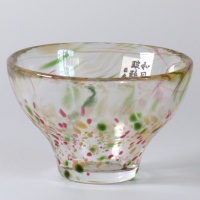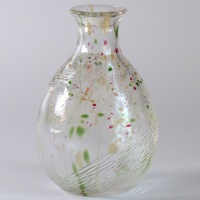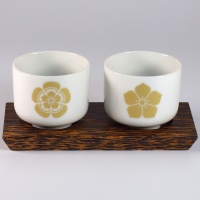Loaded with symbolism and a spirit of togetherness, Kagami Biraki is a Japanese ritual that marks a fresh start - whether it’s a new year, a marriage or a new business venture.
You may have heard of Kagami Biraki in the context of Japanese New Year celebrations but this meaningful ceremony goes far beyond that. Let’s take a closer look at the meaning of Kagami Biraki, when it’s performed and the thoughts behind this centuries-old tradition.
What is Kagami Biraki?
The phrase Kagami Biraki (鏡開き) literally translates as “opening the mirror”, with kagami (a mirror) symbolising harmony and completeness. In practice, it refers to the gentle breaking open of something sacred, most often round rice cakes (kagami mochi) or a ceremonial sake barrel (komodaru).
The act of breaking or more accurately, opening, is never done with a knife as that would suggest violence or division. Instead, the item is opened with care, often using hands or, in the case of a barrel, a wooden mallet. This reflects the desire to open up to good fortune, rather than forcing it.
The New Year tradition
The most widely recognised version of Kagami Biraki takes place in early January, typically on January 11th, in Japan.

During the Japanese New Year period, families display kagami mochi, two round, stacked rice cakes, on a home altar or in a special place in the house. These mochi are offered to the gods during the New Year celebrations and are left out until Kagami Biraki.
On the 11th, the mochi is ceremonially broken apart and eaten, often in a warming soup called ozoni. This act symbolises absorbing the strength of the gods and starting the new year with renewed energy and good luck.
*
This version of Kagami Biraki is also observed in martial arts dojos across Japan, where students come together to eat mochi and re-dedicate themselves to training in the year ahead.
Not just for New Year – Other occasions for Kagami Biraki
While most people associate Kagami Biraki with New Year, the ceremony is also performed at other significant milestones and celebrations. In these cases, it often involves breaking open a sake barrel, a variation which is also sometimes known as Kagami Wari.
Weddings

At traditional Japanese weddings, Kagami Biraki is performed to celebrate the couple’s union and wish them a harmonious life together. The lid of a sake barrel is broken open with wooden mallets and the sake inside is shared with guests. It’s a lovely symbol of sharing joy and good fortune.
Company inaugurations, celebrations and milestones
Businesses often perform Kagami Biraki at launch events, anniversaries, or New Year parties where a sake barrel is opened to wish for prosperity and success. It’s a popular ritual in industries like hospitality, retail and even sumo wrestling tournaments!
Martial arts dojos
In the world of martial arts like kendo, judo, aikido and karate, Kagami Biraki holds a spiritual significance. The ceremony marks the first official training of the year, with students gathering to reflect, reconnect and share mochi or sake. It's a time to renew one’s fighting spirit with humility and focus.
High-profile ceremonies
Kagami Biraki has also been included at prestigious and national events. During royal wedding celebrations, such as those of Crown Prince Fumihito, the ritual of sake barrel opening was part of the reception.
It’s also commonly seen at public inaugurations, like new Shinkansen line launches or major company openings, where government officials and dignitaries symbolically break open a barrel of sake in front of the media.
One especially prominent annual event is the Kagami Biraki Ceremony at Nippon Budokan in Tokyo. It’s attended by martial arts masters and even members of government.
This ceremony blends tradition, respect, and national pride - all hallmarks of Kagami Biraki.
A glimpse into the history of Kagami Biraki
The tradition of Kagami Biraki is believed to date back to the 17th century, during the Edo period.
It is said to have originated with Tokugawa Ietsuna, the fourth shogun of the Tokugawa dynasty. Before going into battle, he and his generals would open a sake barrel together to strengthen their bond and pray for victory. As time went on, the practice evolved into a tradition for celebrating all kinds of auspicious new beginnings.
This origin story also helps explain Kagami Biraki’s close connection to martial arts and the samurai values of courage, unity and discipline.
Traditional elements and symbolism
Just like other traditions, this Japanese ceremony is filled with meaningful details. Here are a few notable points about Kagami Biraki:
No knives allowed
Knives are never used during Kagami Biraki. Cutting suggests division, while breaking by hand or wooden mallet preserves the spirit of harmony.

The shape of the ‘mirror’
The word kagami refers to a round mirror, considered sacred in Shinto belief. Mirrors are believed to reflect the soul and their round shape symbolises balance and completeness. In the Kagami Biraki ceremony the round mirror is represented by the round top of the sake barrel or smooth round shape of a mochi rice ball.
The sake ceremony
At weddings and corporate events, the breaking open of a komodaru (sake barrel) is followed by the sharing of sake, usually served in small wooden masu cups. This joyful act of toasting to shared happiness is also known as Kagami-wari.
Household display
During traditional Japanese New Year celebrations, kagami mochi are often displayed in the tokonoma, a traditional alcove, or on the family kamidana (Shinto altar) and may be decorated with a small citrus fruit called daidai, whose name also means "from generation to generation."
A ceremony you can try at home
Even if you're outside Japan, you can bring a little Kagami Biraki into your own celebrations:
- Share sake with friends or loved ones to mark a new beginning, be it a wedding, a new home or a fresh project.
- Display kagami mochi (or a symbolic version) during the New Year and enjoy a rice cake meal on January 11th.
- Take a moment to reflect and open yourself to new beginnings or simply the new season ahead. This is the heart of what Kagami Biraki is all about.
Whether simple or grand, this ceremony reminds us that new chapters are best opened with gratitude, community, and a shared sense of hope.
Send your best wishes and share some sake
Celebrate new beginnings with these Japanese products:
*
*












